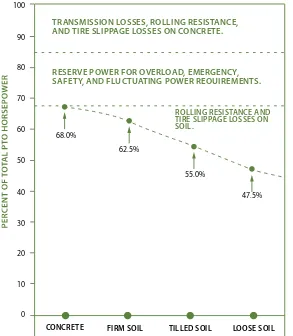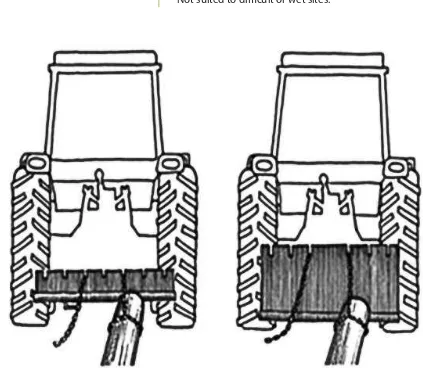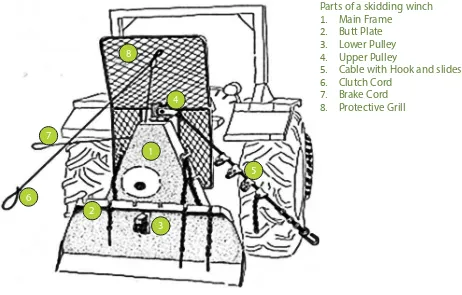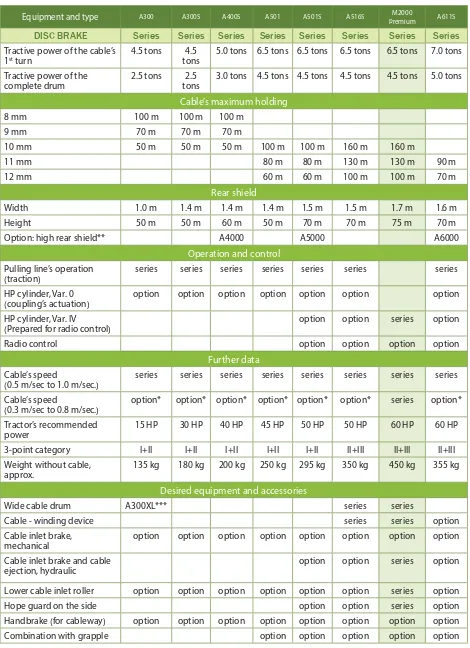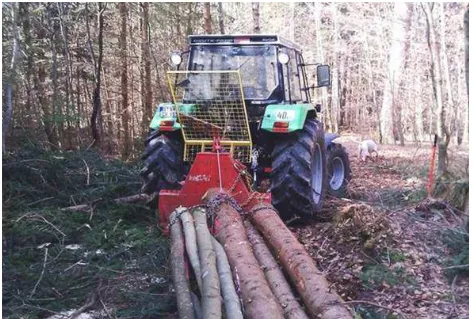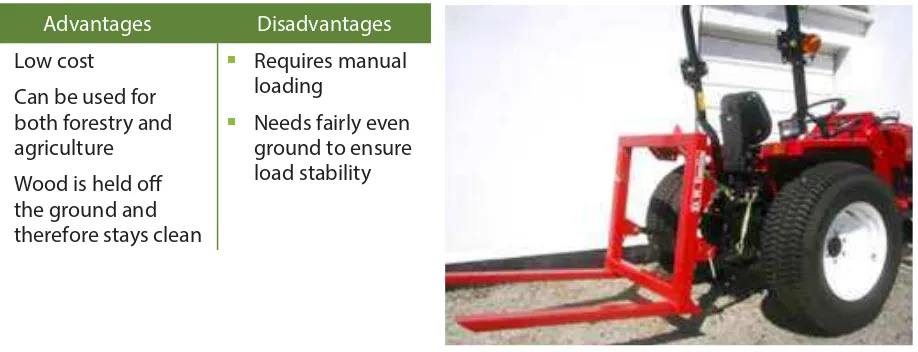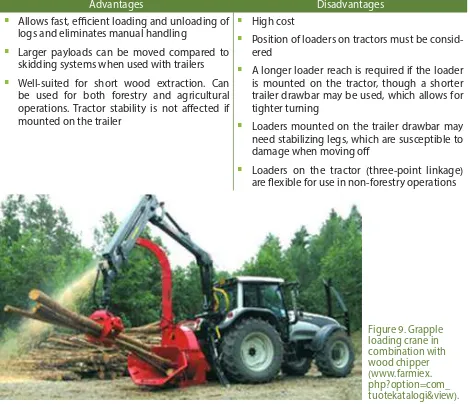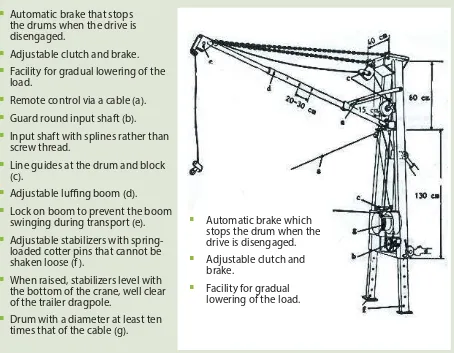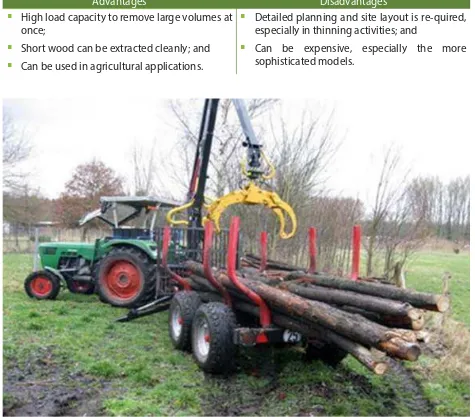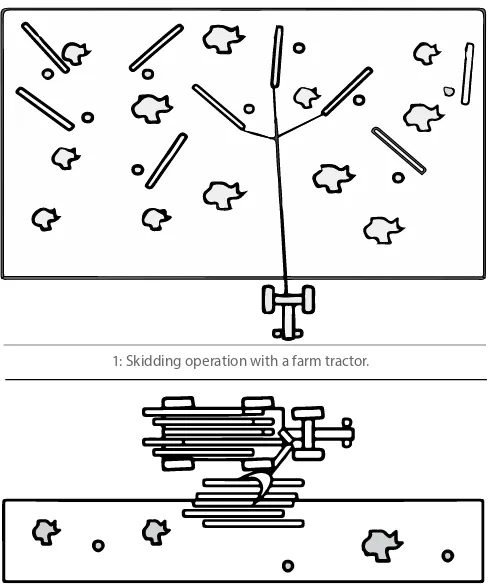Agricultural tractors
RECOFTC - The Center for People and Forests
Copyright © RECOFTC December 2015 Bangkok, Thailand
All photos courtesy of RECOFTC except where reference is indicated
Reproduction of this publication for educational or other non-commercial purposes is authorized without prior written permission from the copyright holders provided the source is fully acknowledged. Reproduction of this publication for resale or other commercial purposes is prohibited without written permission of the copyright holder.
This publication has been generously funded by the Ministry for Foreign Afairs of Finland. The views expressed in this publication are those of the authors and do not necessarily relect the views of RECOFTC and our donor organizations.
Table of contents
1. Introduction
1
2. Key forestry implements for attachment to
agricultural tractors
5
2.1 Skidding bar and plate 5
2.2 Skidding winch 6
2.3 Skidding and forwarding grapple 8
2.4 Back fork 9
2.5 Grapple loading crane 9
2.6 Wire-crane loader 10
2.7 Log trailer 12
2.8 Tractor-based harvesters and processors 16
3. Performance studies for agricultural tractors
in wood extraction
15
3.1 Cordero, w and howard, a (1995) 15
3.2 Spinelli (2005) 15
3.3 Le doux and huyler (1992) 16 3.4 Hofman r.e. et al (1982) 16
4. Farm tractor and winch attachment in bamboo harvesting
19
Recommendations 20
References
22
Figures
Figure 1. Agricultural tractor with forest harvesting modiications 2 Figure 2. Net pulling power available at the tractor drawbar in relation to four
surface conditions (White 1977) 2 Figure 3. Skidding bar and butt plate for rear attachment (Nova Scotia Natural Resources 2006) 5 Figure 4. Basic skidding winch for tractor attachment 6 Figure 5. Agricultural tractor with logging winch in action 8 Figure 6. Rear mounted skidding grapple (www.maxwald.com). 9 Figure 7. Front grapple loader (www.worksaver.com/product/compactgrapple.html). 9 Figure 8. Tractor mounted back fork (www.lizardtractors.co.uk/acatalog/info_RMPF.html) 9 Figure 9. Grapple loading crane in combination with wood chipper
(www.farmiex.php?option=com_tuotekatalogi&view). 10 Figure 10. Sketch of wire crane loader for attachment to farm tractors 11 Figure 11. Loading small diameter logs with wire loader 11 Figure 12. Agricultural tractor with 3.5 tonne log trailer and grapple crane
(www.com%25257Cuserbilder%25257C513) 12 Figure 13. Typical skidding and forwarding operations with farm tractors (Akay 2005) 13 Figure 14. Farm tractor with front mounted harvester
(www.Naarva-boom-kit-S23-agriculturaltractor-logging.jpg) 13 Figure 15. Percentage cost distribution in oxen and tractor based log extraction
(Cordero W, and Howard, A 1995) 15 Figure 16. Extraction productivity as a function of skidding distance and piece size. 16 Figure 17. Extraction of bamboo using Juwel 3 to winch with a Kubota 35 HP farm tractor 19
Tables
Table 1. Tractor-winch combination (Maxwald, Austria) 7 Table 2. Performance of small agricultural tractors in log extraction trials in small-sized
broadleaved stands (Le Doux and Huyler 1992). 16 Table 3. Comparison of cable and grapple skidding cycle times and production rates
1. Introduction
Agricultural tractors with attached winches, grapple tongues and log trailers with cranes are the key machines for small-scale forestry work in developed countries. In the near future, a similar role is also foreseen in small-scale community forestry work in Asia and the Paciic. The choice of tractor type and equipment for forestry adaptation depends on terrain (uphill or downhill), log sizes and intensity of harvesting operations. Forestry work can be very demanding on tractors, especially on engine capacity, gear systems, tires, body as well as other parts.
Basic modiications, such as window and radiator protection, screens or grills, delector and cab protection bars, valve stem protectors, belly pans and front weights are required. When Power Take Of (PTO)-driven attachments are used, due care must be observed in covering the PTO. The three-point hitch is suicient for some equipment. However, heavier equipment, such as loaders, requires a irm attachment to the tractor.
One of the major problems when using a farm tractor in forestry is the orientation of the operator’s cab. Almost all tractor cabs are designed with a forward-facing operating position. Many forestry implements, such as grapple-loader trailers, skidding and forwarding grapples and winch processors require the operator to face the rear of the tractor. In most cases, tractor operators have to twist their bodies or kneel on the seat to reach the respective levers of the various tractor attachments. If a tractor has a less than ergonomically suitable cab, it is important that the operator tries to diversify the workload to minimize time spent in awkward working positions. Reversible seats and controls and increased space at the rear of the cab can help overcome this diiculty. Some tractor manufacturers provide these features as standard options.
The weight distribution ratio between the front and rear axles and their efect on traction power varies signiicantly between two- and four-wheel drive tractors. Ideally, a 50:50 front- to rear-end weight ratio is desirable for forestry machinery. Weight distribution of two-wheel drive tractors, which have a front- to rear-end ratio of 30:70, can be improved by adding front weights. The weight distribution of four-wheel drive tractors, which have a front- to rear ratio of 45:55, improves stability and pulling power. It is also recommended that special tire chains with reinforced links be used to prevent wheels from slipping during extraction, especially on sloping terrain.
Figure 1. Agricultural tractor with forest harvesting modiications
Three-point hitch systems allow attachments, such as winches, skidders, grapples and processors. Stability deiciencies associated with a three-point linkage can be overcome by using a four-point hitch, which is best suited for grapple loaders, winch processors and double-drum winches. Additional pressure on the lower rear holding links to the shield of the logging winches, helps anchor the tractor during winch pulling. It is important, moreover, that forestry implements are matched to the sizes and power ratings of tractors. For example, it is impractical to mount a high capacity implement, such as a processor on a small 30 kW (40 hp) two-wheel drive tractor, because the tractor will become unstable and the engine or hydraulic system will be unable to power the machine. As a rule of thumb, an engine capacity of 10 kW is required for every ton of load that needs to be pulled. For steep terrain situations, a higher engine capacity is required. As White (1977) showed, soil and surface conditions play decisive roles in reducing a tractor engine’s pulling power by up to 50 percent.
Figure 2. Net pulling power available at the tractor drawbar in relation to four surface conditions (White 1977)
Valve stem protector
CONCRETE FIRM SOIL TILLED SOIL LOOSE SOIL
ROLLING RESISTANCE AND TIRE SLIPPAGE LOSSES ON SOIL.
2. Key forestry implements for attachment to
agricultural tractors
2.1 Skidding bar and plate
The notched skidding bar is a device that is attached to a tractor’s three-point linkage. It is used to skid logs that are choked and attached to it. The bar is simply lifted using its links and the attached logs are dragged behind the tractor. This is a very simple piece of equipment and, with the exception of adding front-end weights, requires very little modiication to the agricultural tractor. Heavier steel plates or butt plates are larger and adding these allows for a higher pulling point, which is more efective at raising logs of the ground. Most wire cranes and skid winches are equipped with skidding bars.
Advantages Disadvantages
§
§
Low cost§
§
Suited to a wide range of tractors§
§
Low productivity§
§
Limited application in thinning operations since tractor needs to drive to the log for extraction§
§
Weight distribution of many farm tractors may present safety risks§
§
Not suited to diicult or wet sites.2.2 Skidding winch
Skidding winches use a cable and choker to pull one or more trees. The skidding winch is normally attached to the three-point hitch and receives its power from the tractor PTO. Power winches are made to suit a wide range of tractors (22 kW, 30 hp to 75 kW, 100 hp).
Advantages Disadvantages
§
§
Low to medium cost§
§
Suited to a wide range of tractors and site types§
§
When using winches on diicult terrain, the load can be dropped and the tractor can move to a more favorable location and winch the log from that distance.§
§
Limited application in thinning§
§
Skidding often produces dirty logs, which can cause diiculties at the processing stage, especially when chipping at the roadside§
§
Can contribute to both soil and residual tree damageThe following table provides an overview of key relationships to consider when selecting a tractor-winch combination. Key factors include: the traction power range of the tractor-winch (expressed on irst turn of cable and complete drum), the cable holding capacity as a function of cable diameter, the dimension of the rear shield (mainly its width, which should not exceed the rear wheel outer breadth), the weight of the winch and the tractor’s engine power.
Parts of a skidding winch 1. Main Frame
2. Butt Plate 3. Lower Pulley 4. Upper Pulley
5. Cable with Hook and slides 6. Clutch Cord
7. Brake Cord 8. Protective Grill
Figure 4. Basic skidding winch for tractor attachment
Table 1. Tractor-winch combination (Maxwald, Austria)
Equipment and type A300 A300S A400S A501 A501S A516S M2000
Premium A611S
DISC BRAKE Series Series Series Series Series Series Series Series
Tractive power of the cable’s
1st turn 4.5 tons tons4.5 5.0 tons 6.5 tons 6.5 tons 6.5 tons 6.5 tons 7.0 tons
Tractive power of the
complete drum 2.5 tons tons2.5 3.0 tons 4.5 tons 4.5 tons 4.5 tons 4.5 tons 5.0 tons
Cable’s maximum holding
Option: high rear shield** A4000 A5000 A6000
Operation and control
Pulling line’s operation
(traction) series series series series series series series
HP cylinder, Var. 0
(coupling’s actuation) option option option option option option option HP cylinder, Var. IV
(Prepared for radio control) option option series option
Radio control option option option option
Further data
Cable’s speed
(0.5 m/sec to 1.0 m/sec.) series series series series series series series series Cable’s speed
(0.3 m/sec to 0.8 m/sec.) option* option* option* option* option* option* series option* Tractor’s recommended
power 15 HP 30 HP 40 HP 45 HP 50 HP 50 HP 60 HP 60 HP
3-point category I+II I+II I+II I+II I+II II+III II+III II+III
Weight without cable,
approx. 135 kg 180 kg 200 kg 250 kg 295 kg 350 kg 450 kg 355 kg
Desired equipment and accessories
Wide cable drum A300XL*** series series
Cable - winding device series series option
Cable inlet brake,
mechanical option option option option option option option option Cable inlet brake and cable
ejection, hydraulic option option series option
Lower cable inlet roller option option option option option option series option
Hope guard on the side option option series option
Handbrake (for cableway) option option option option option option option option
Figure 5. Agricultural tractor with logging winch in action
2.3 Skidding and forwarding grapple
Hydraulic grapples mounted on the three-point hitch or in the front of the tractor can be used equally well for transporting cut-to-length logs and full pole-length timber. To do this, the operator reverses the tractor up to the logs or timber stack and ‘grapples’ the load, which is then hydraulically lifted for transportation.
Power requirement: Optimal front-to-rear weight ratios are needed to meet tractor power requirements. The skidding and forwarding grapple attachment is best suited to four-wheel drive tractors with compensatory front weight attachments. The actual size of the tractor depends on the size of the implement and the weight of the wood to be carried or skidded. The minimum size required is approximately 41 kW (55 hp).
Advantages Disadvantages
§
§
Relatively inexpensive§
§
Short wood can be extracted clean§
§
The operator does not need to leave the cab during loading.§
§
Requires careful bundling of material and does not have the lexibility and versatility of skidders§
2.4 Back fork
Back forks are low-cost extraction implements that are mounted on the three-point hitch to forward short wood.
Power requirement: Tractors need optimal front-to-rear weight ratios, which makes this implement best-suited to four-wheel drive tractors with compensatory front weight attachments.
Advantages Disadvantages
§
§
Low cost§
§
Can be used for both forestry and agriculture§
§
Wood is held of the ground and therefore stays clean§
§
Requires manual loading§
§
Needs fairly even ground to ensure load stabilityFigure 8. Tractor mounted back fork (www. lizardtractors.co.uk/acatalog/info_RMPF.html)
2.5 Grapple loading crane
Grapple loading cranes are hydraulic cranes with a grapple. This attachment can be used to pick up single trees or bunched logs for loading or unloading when using a trailer. The crane can be mounted on the tractor’s three-point hitch or on the trailer.
Figure 6. Rear mounted skidding grapple (www.maxwald.com).
Power requirement: Most tractors can easily supply the hydraulic pump capacity requirement of 25 l/ min to 50 l/min.
Advantages Disadvantages
§
§
Allows fast, eicient loading and unloading of logs and eliminates manual handling§
§
Larger payloads can be moved compared to skidding systems when used with trailers§
§
Well-suited for short wood extraction. Can be used for both forestry and agricultural operations. Tractor stability is not afected if mounted on the trailer§
§
High cost§
§
Position of loaders on tractors must be consid-ered§
§
A longer loader reach is required if the loader is mounted on the tractor, though a shorter trailer drawbar may be used, which allows for tighter turning§
§
Loaders mounted on the trailer drawbar may need stabilizing legs, which are susceptible to damage when moving of§
§
Loaders on the tractor (three-point linkage) are lexible for use in non-forestry operationsFigure 9. Grapple
The wire crane is essentially a PTO-powered winch with a high A-shaped steel frame and stabilizer legs. Wire cranes are commonly used with a forestry trailer for winching, loading and forwarding wood. The operator walks up to each bundle, puts a wire around it and follows the bundle as it is winched back to the tractor. This tool is compatible with nearly all tractor sizes.
Advantages Disadvantages
§
§
Suitable for thinning operations with widely spaced racks§
§
Short wood can be extracted cleanly§
§
Wire-crane loaders are the least expensive mechanical loading systems available§
§
Ideal implement for start-up operations and when inancial resources are limited since no additional loading equipment is required§
§
Operator safety is decreased§
§
Substantial wood handling and walking is required§
§
Productivity tends to be lower than that of grapple loaders§
Figure 10. Sketch of wire crane loader for attachment to farm tractors
Figure 11. Loading small diameter logs with wire loader
§
§
Automatic brake that stops the drums when the drive is disengaged.§
§
Adjustable clutch and brake.§
§
Facility for gradual lowering of the load.§
§
Remote control via a cable (a).§
§
Guard round input shaft (b).§
§
Input shaft with splines rather than screw thread.§
§
Line guides at the drum and block (c).§
§
Adjustable luing boom (d).§
§
Lock on boom to prevent the boom swinging during transport (e).§
§
Adjustable stabilizers with spring-loaded cotter pins that cannot be shaken loose (f).§
§
When raised, stabilizers level with the bottom of the crane, well clear of the trailer dragpole.§
§
Drum with a diameter at least ten times that of the cable (g).§
§
Automatic brake which stops the drum when the drive is disengaged.§
§
Adjustable clutch and brake.§
2.7 Log trailer
There is a wide range of log trailers available for agricultural tractors from non-driven units to more sophisticated power-driven trailers. Most popular tractor-drawn models may have payloads ranging from three meters (m)3 to eight m3 with ive-ton models being the most common. Three- to ive-ton
trailers are suitable for lower-powered tractors (less than 37 kW, 50 hp) and part-time usage.
Forestry trailers are built with a skeletal construction in order to maximize payload capacity. The smallest capacity trailers may only have two wheels. However, most forest models have a four-wheel ‘bogie’ or centrally-suspended axle joint construction. Such combinations start with agricultural tractors of about 30 hp and 3.5-ton trailers, as shown in Figure 12.
Figure 12 illustrates a typical combination of a farm tractor and logging winch used for skidding and forwarding to irst landing, followed by the subsequent transportation of logs using a tractor-trailer combination on forest roads to second landings.
Advantages Disadvantages
§
§
High load capacity to remove large volumes at once;§
§
Short wood can be extracted cleanly; and§
§
Can be used in agricultural applications.§
§
Detailed planning and site layout is re-quired, especially in thinning activities; and§
§
Can be expensive, especially the more sophisticated models.Figure 13. Typical skidding and forwarding operations with farm tractors (Akay 2005)
2.8 Tractor-based harvesters and processors
The most advanced farm-forestry implements for tractors are the harvester and the processor, which can either be front or rear attachments (Johansson, J 1996). The diference between a harvester and a processor in forestry terms is that a harvester fells, delimbs and cross-cuts trees into products, while a processor takes previously felled trees
and delimbs and cross-cuts them. There are, moreover, two categories of processors: grapple and wire. The irst uses a grapple loader to bring the tree to the processor while the wire processor uses a winch. These systems are only briely mentioned here since the costs for both types of tractors with engine capacities well over 100 kW (costing over US$ 80 000) and their respective attachments (costing over US$ 25 000) are beyond the small-scale category covered by this guidebook.
Figure 14. Farm tractor with front mounted harvester (www. Naarva-boom-kit-S23-agricultural-tractor-logging.jpg) 1: Skidding operation with a farm tractor.
3. Performance studies for agricultural
tractors in wood extraction
3.1 Cordero, w and howard, a (1995)
Cordero, W and Howard, A (1995) compared the cost structure between traditional log extraction by oxen and the modern method of using tractors. As shown in Figure 15, 83 percent of system costs in oxen logging are attributed to labor, which can be reduced to as low as 20 percent by using tractors. It is important to understand this relationship in consideration of increasing labor shortages in many rural regions and in view of competition
with agricultural income opportunities. In many situations, however, animal logging is not in place or has vanished (e.g. elephant or bufalo logging in Southeast Asia) and it is doubtful that introduction or re-introduction is the recommended pathway. It appears to be more advantageous to adopt agricultural mechanization and adapt farm tractors in forest harvesting systems.
Figure 15. Percentage cost distribution in oxen and tractor based log extraction (Cordero W, and Howard, A 1995)
3.2 Spinelli (2005)
Spinelli (2005) studied the efect of average piece size and large extraction distances of up to 1 400 m, which is typical for many areas in the target regions of this guidebook. Spinelli’s study involved six tractor models ranging from 48 kW to 116 kW in three high forest and three coppice forest areas in Italy. Piece sizes ranged from 0.1 m3 to 1.5 m3 per piece and had an inluence of around 100 percent
in each distance situation. Distance afected extraction performance and dropped by 75 percent for small pieces and by 40 percent for big pieces. The relationship is extremely important and is relected in basically all studies with tractors. Implements bundling smaller size materials into bigger loads are decisive in addressing the volume (weight) per piece ratio. Similar results for farm tractors were found in a study by Özturk (2011) in the mountainous regions of northern Turkey.
Figure 16. Extraction productivity as a function of skidding distance and piece size.
Note: the curves were calculated for a 70kW tractor, a two-man crew and a winching distance of 15 m (Spinelli 2005).
3.3 Le doux and huyler (1992)
Le Doux and Huyler (1992) carried out a comparative study between small agricultural tractors with winch and boom loader attachments over an extraction distance of 400 m. Productivity of the systems varied by up to 100 percent. Huyler (1984) provided similar results derived from comparable machines. It is interesting to note that the example of a highly specialized small-scale harvesting machine like the
Forest Ant with only 12 hp gave comparatively high performance in log extraction (refer to Table 2).
Table 2: Performance of small agricultural tractors in log extraction trials in small-sized broadleaved stands (Le Doux and Huyler 1992).
Tractor Winch/Loading type HP Stems/
turn Volume/turn
Massey Ferguson 184-4 Farmi JL-456 60 3.78 1.31 4.78 3.76 Same Minitaurus Farmi JL 30 60 3.96 1.85 4.05 2.89 Holder A60 IGLAND double drum 3000 48 5.67 1.38 6.70 5.58 Pasquali 993 Farmi JL 25 30 3.94 0.65 3.66 2.46 Forest Ant Knuckleboom loader 12 7.10 1.0 5.03 3.40
3.4 Hoffman r.e. et al (1982)
Hofman, R.E. et al. (1982) studied the diferences between a rear mounted cable winch and a grapple attachment on a 55 hp Holder Mini tractor. Over short distances (30 m), the grapple-based system had a higher productivity of 35 percent compared to the cable winch. This gradually decreased to 20 percent when distance was increased to 150 m due to the corresponding increase in travel time during the extraction cycle. If logs are pre-bundled at intermediate landings, the advantage of the grapple system is particularly striking as shown by Akay (2005).
Table 3: Comparison of cable and grapple skidding cycle times and production rates for the Holder A55F tractor in relation to extraction distance (Hofman 1982).
Travel distance
Total productive
cycle time scheduled hourCycles per
Production per scheduled hour
Cunits Trees
Cable Grapple Cable Grapple Cable Grapple Cable Grapple
Ft. Min. Min. Cycles Cycles Cunits Cunits Trees Trees
100 6.34 4.30 6.62 9.77 1.3207 1.9491 19.86 29.31
150 6.81 4.79 6.17 8.77 1.2309 1.7496 18.51 26.31
200 7.29 5.28 5.76 7.95 1.1491 1.5860 17.28 23.85
250 7.76 5.76 5.41 7.29 1.0793 1.4543 16.23 21.87
300 8.24 6.25 5.10 6.72 1.0175 1.3406 15.30 20.16
350 8.71 6.73 4.82 6.24 0.9616 1.2449 14.46 18.72
400 9.19 7.22 4.57 5.82 0.9117 1.1611 13.71 17.46
450 9.66 7.70 4.35 5.45 0.8678 1.0873 13.05 16.35
500 10.14 8.19 4.14 5.13 0.8259 1.0234 12.42 15.39
1 Assumptions: Average DBH = 8.00 in.; average total height = 55ft.; volume per stem = 6.65 cu.ft. (U.S.Forest Service, 1929); average number
4. Farm tractor and winch attachment in
bamboo harvesting
RECOFTC – The Center for People and Forests carried out intensive harvesting trials on bamboo (Dendrocalamus membranaceus, local name Mai Sang) during the dry season of 2013-2014 in Bokeo province, northern Lao PDR (Salakka, 2014). These trials studied extraction costs for bamboo culms – with and without branches – that were transported to roadsides and converted into biomass chips to assess the feasibility of using biomass fuel chips value chain for power generation. The trials were the irst trials of their kind on record. A Kubota 35 HP farm tractor was used with a Juwel 3 logging winch iron horse and a local crawler converted from a Yanmar rice harvester hand sulky. Motor winches were also used for skidding in the comparative trials.
The tractor was used for both winching and skidding bamboo while assisting in the extraction process during felling of whole bamboo clumps of about 15 to 25 culms, including dead materials. Due to the large size of the bamboo bundles, rough delimbing had to be undertaken to reduce volume. The extraction distance was 100 m. The winch wire was 60 m long and it was necessary to move the tractor once or twice before it had to be re-winched. Besides re-winching, forwarding was tested after winching by removing bundles by dragging them behind the tractor. However, due to the heavy weight of the bundle, the tractor’s front wheels rose up from the ground. This method would be faster but requires an additional weight pack attached to the front of the tractor.
Winching and delimbing phases were studied separately due to the long distance (100 m) separating felling sites from delimbing sites. Productivity was 0.490 tons per hectare (before delimbing/stacking) when bundles were extracted from 100 m. The productivity of one person was calculated at 0.245 tons per hectare. The average cycle time was 43.5 minutes and over half of this time (52.15 percent) was spent waiting, essentially the period that the chainsaw operator was felling the logs. The extraction volume was computed to be 0.355 tons. The winch productivity for a distance of 100 m, if recalculated to remove the waiting time, would be 1 024 tonnes per hectare. The productivity of rough delimbing was 1 772 tonnes per hectare. The next phase, stacking, achieved a performance level of 0.890 tonnes per hectare. The average cycle time was 40.6 minutes. The combined productivity of delimbing and stacking was 0.590 tons per hectare.
In a situation where two operators work simultaneously, the total productivity can be improved if one person is in charge of both chainsaw and winch work, while the other is in charge of delimbing and stacking. Presuming that 52.15 percent of the winch operator’s waiting time can be eliminated by assigning chainsaw work and improving extraction speed by gaining the tractor driving speed, these changes will signiicantly improve each person’s productivity: Total productivity per person can be increased to approximately 0.450 tonnes per hectare. This productivity rate, if repeated within a period of eight
tons per day. If overall productivity of rough delimbing and stacking can be sustained at the level of 0.590 tons per hectare, it would require approximately six hours to delimb and stack 3.6 tons. This result is equivalent to 1.8 tons/day/person or 0.225 tons/hectare/person. Given the extremely small weight-piece ratio of 11 kilogram (kg) fresh weight, these preliminary results are very encouraging for work involving bamboo.
Recommendations
REFERENCES
Acar, H H 1997, “Investigation of extraction with forest tractors on mountainous areas,” Turkish Journal of Agriculture and Forestry, Vol. 21, No. 3, pp. 299–306.
Akay, A E 2005, “Using Farm Tractors in Small-Scale Forest Harvesting Operations, Department of Forest Engineering,” Faculty of Forestry, Kahramanmaras, Turkey. Journal of Applied Sciences Research, Vol. 1, No. 2, pp. 196-199.
Çalışkan, E 2012, “Productivity and cost analysis of manual felling and skidding in Oriental spruce (Picea orientalis L.) forests,” Annals of Forest Research Journal, Vol. 55, No. 2, pp. 297-308.
Cordero, W and Howard, A 1995, “Use of oxen in logging operations in rural areas of Costa Rica Proceedings,” S3.05, IUFRO World Congress Symposium, pp. 5-12.
FAO 1986, “Wood extraction with oxen and agricultural tractors,” Food and Agriculture Organisation (FAO) of the United Nations, pp. 49-91.
Forestry Commission UK 2001, “Compact Tractor Skidder Information Note,” ODW 8.07, Forestry Commission United Kingdom (UK), p. 3.
Forskningsstiftelsen Skogsarbeten 1983, Swedish forestry techniques with possible applications in the third world, Stockholm, p. 342.
Gallis, C and Spyroglou, G 2012, “Productivity linear regression models of tree-length harvesting system in natural aleppo pine (pinus halepensis) forests in the Chalkidiki area of Greece,” Croatian Journal of Forest Engineering, pp. 115-123.
Ghafariyan, M R, Naghdi, R, Ghajar, I and Nikooy, M 2012, “Time prediction models and cost evaluation of cut-to-length (CTL) harvesting method in a mountainous forest,” Small-scale Forestry, .
Gilanipoor, N, Najai, A and Heshmat Alvaezin, S M 2012, “Productivity and cost of farm tractor skidding,” Journal of Forest Science, Vol. 58, No. 1, pp. 21–26.
Gullberg, T and Johansson, J 1992, “Farm tractor based single grip harvesters, Swedish University of Agricultural Sciences,” Department of Forest Extension, Garpenberg, Sweden, Small-scale Forestry, pp. 9-14.
Heinimann, R 1999, “Ground-based harvesting technologies for steep slopes,” Department of Forest Engineering, Oregon State University, Corvallis, Oregon, United States.
Hofman, R E, et al 1982, “Evaluation of the holder A55F logging tractor,” Alabama Agricultural Experiment Station Bulletin, No. 539, p. 33.
Huyler, N K, Koten, D E, Lea, R V and Quadro, A P 1984, “Productivity and cost of three small fuel wood skidders,” Journal of Forestry, pp. 671-674.
Huyler, N K and Le Doux C B 1991, “A comparison of small tractors for thinning central hardwoods in proceedings during the 8th Central Hardwood Forest Conference,” USDA Forest Service, Philadelphia,
Pennsylvania, United States, pp. 92-104.
Johansson, J 1997, “Small tree harvesting with a farm tractor and crane attached to the front,” Journal of Forestry Engineering, Vol. 8, No. 1, pp. 21–33.
Le Doux, C B and Huyler, N K 1992, “Cycle time equations for ive small tractors operating in low volume small diameter hardwood stands,” USDA Northern Forest Experiment Station Research Paper, NE 664, p. 6.
Melemez, K, Tunay M, and Emir, T 2014, “A Comparison of Productivity in ive small-scale harvesting systems,” Small-scale Forestry, Vol. 13, No. 1, pp. 35-45.
Nova Scotia Natural Resources 2006, “Woodlot Management Home Study Course, Module 12, Small Scale Harvesting Equipment Manual,” Nova Scotia Natural Resources, p. 66.
Özturk, T 2011, “Productivity of New Holland farm tractor at beech stands in mountainous areas in the Black Sea region,” Istanbul University, Faculty of Forestry, Department of Forest Construction and Transportation, Turkey, Forestry Ideas, Vol. 16, No. 1, p. 39.
Ryyninen, S 1994, “Farm tractor harvester in irst thinning of pine,” Work Eiciency Institute, Helsinki, TyStehoseuranjulkaisuja, No.338,68p. (In Finnish with English summary)
Spinelli, R and Magagnotti, N 2012, Wood Extraction with Farm Tractor and Sulky: Estimating Productivity, Cost and Energy Consumption, Small-scale Forestry, Vol. 11, pp. 73–85.
Turk, Y and Gumus, S 2010, “Log skidding with farm tractors,” FORMEC 2010 Forest Engineering: Meeting the Needs of the Society and the Environment conference paper 11-14 July 2010, Padova, Italy, p. 6. White, R 1977, “Matching tractor horsepower and farm implement size,” Farming Know How, Michigan State University Extension Bulletin, East Lansing, Michigan, United States, E 1152 SF 11.
APPENDIX
1. Machine cost calculation
Manufacturer: ______________________________ Model: ____________________ HP: _________________________
Purchase price:
Total price of transportation to site:
Total:
$ ______________________________
$ ______________________________
$ ______________________________
(P) INITIAL INVESTMENT $_________________
(S) Salvage Value (____% of P) $_________________
(N) Estimated Life: ____ years
(SH) Scheduled operating time: ___ hrs/yr
(U) Utilization: ___ %
(H) Productive time ____ hrs/yr
(AVI) Average value of yearly investment
AVI = [((P-S)(N+1))/2N]+S $_________/yr
I. Fixed cost:
Depreciation= (P-S)/N $_______/yr
Interest (____ %), Insurance (____ %), Taxes (____ %)
Total ____ % x ($____/yr) $_______/yr
(1) Fixed cost per year $_______
(2) Fixed cost per H (1÷H) $_______
II. Operating cost: (based on productive time)
Maintenance and repair (_____% x ((P-S)/(N x H)) $_______
Fuel (____ L x $____/L) $_______
Oil & lubricants $_______
Tires (1.15 x (tire cost)/tire life in hrs.) $_______
(3) Operating cost per H $_______
III. Machine cost per H (without labor) (2+3) $_______
IV. Labor cost ($_____/hr ÷U) $_______
RECOFTC’s mission is to enhance capacities for stronger rights, improved governance and fairer beneits for local people in sustainable forested landscapes in the Asia and the Paciic region.
RECOFTC holds a unique and important place in the world of forestry. It is the only international not-for-proit organization that specializes in capacity development for community forestry. RECOFTC engages in strategic networks and efective partnerships with governments, nongovernmental organizations, civil society, the private sector, local people and research and educational institutes throughout the Asia-Paciic region and beyond. With over 25 years of international experience and a dynamic approach to capacity development – involving research and analysis, demonstration sites and training products – RECOFTC delivers innovative solutions for people and forests.
RECOFTC – The Center for People and Forests P.O. Box 1111
